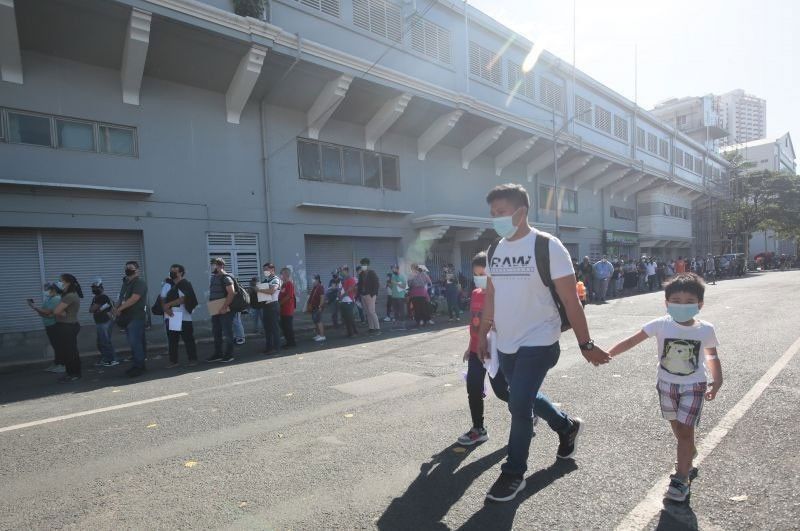Concepcion pushes Alert 1 by March

MANILA, Philippines — As cases are expected to decline to as low as 1,000 per day by the end of this month, presidential adviser for entrepreneurship and Go Negosyo founder Joey Concepcion is pushing for a shift to Alert Level 1 by March, particularly for the National Capital Region (NCR) and other areas with high vaccination rates.
Concepcion also suggested trimming the alert level system to three levels from the current five.
In a Viber message, he said the proposed shift to Alert Level 1 is for Metro Manila and those ready for it with vaccination rates of 70 percent and higher.
“We need to de-escalate our countrymen from crisis mode to recovery mode,” he said.
He added that the shift is important for Filipinos to help rebuild the country by engaging in economic activities, like going to shops, dining out, traveling or going back to work.
Independent group OCTA Research also believes that an Alert Level 1 status will allow the country to sustain the economic growth seen in the fourth quarter last year.
“Now is the time (to open up further), because the science is proving that cases are going down,” OCTA Research head Ranjit Rye said.
OCTA Research fellow Guido David is forecasting that the country’s new COVID-19 infections will drop to 1,000 to 2,000 per day by the end of this month.
At present, Metro Manila as well as Batanes, Bulacan, Cavite, Rizal, Biliran, Southern Leyte and Basilan are under Alert Level 2.
Under a lower alert level, all establishments would be allowed to operate, but there should be minimum health protocols that have been agreed upon to be implemented, according to Concepcion.
“Moving to Alert Level 1 will already have a big effect on how we recover from hereon,” Concepcion said.
He explained that a shift to Alert Level 1 would also give the country an opportunity to see how well it would manage by relying only on maintaining prescribed public health safety protocols.
“Areas with high vaccination rates, I think, can implement a no-alert level status,” he said.
Apart from public health safety protocols to be put in place, Concepcion underscored that the government should also define the conditions when alert level systems can be lifted and people can resume some normal activities.
“I think that as long as there are no variants of concern, and we have already achieved a high vaccination rate and hospital utilization rate is low, we can already start to consider lifting alert levels,” he said.
In an interview with ANC yesterday, Concepcion suggested that alert levels be trimmed by having only Alert Levels 1 to 3 instead of the current 1 to 5.
He said the alert level system should not be scrapped, but set aside when the situation normalizes and brought back when there is a threat.
Concepcion also wants the government to immediately define and set the timing for the administering of booster shots as immunity will eventually wane and there are thousands of vaccines nearing their expiry dates.
“As we require vaccination cards for entry in high-risk areas, we will eventually require boosters as the greater percentage of the population receive their primary doses,” he said.
The presidential adviser is also pushing for the opening face-to-face classes by June, but only to fully vaccinated students.
“Parents also need to have a more predictable schedule so they can plan on returning to work or resuming their normal daily activities. For business, schools have a multiplier effect that simply cannot be matched by any other activity I know,” he said.
Preparing for lower alert level
Metro Manila’s local chief executives are now preparing to ask the Inter-Agency Task Force for the Management of Emerging Infectious Diseases (IATF) to place the NCR under Alert Level 1 if COVID-19 cases will continue to drop in the coming days.
During yesterday’s Laging Handa public briefing, Metro Manila Development Authority (MMDA) acting Chairman Roman Artes said the Metro Manila Council (MMC) has discussed possible recommendations.
“What we have talked about is that if the number of COVID-19 cases continuously declines in Metro Manila, we might request to bring the alert level down to 1,” Artes said.
Metro Manila mayors have been leading renewed efforts to contain the problem and are now looking at asking the IATF to ease the restrictions as infections decline.
“It’s continuously going down, and if we reach the threshold to be lowered down to Alert Level 1, we will request the IATF,” Artes said.
He added that placing the NCR under a lower alert level soon would help reopen the economy in Metro Manila.
As this developed, the country yesterday logged its lowest single-day tally for new COVD-19 cases since Jan. 1 at 3,574, according to the Department of Health (DOH).
This brings the total cases of COVID-19 in the country to 3,619,633.
DOH data showed that the lowest daily tally was recorded last Jan. 1 at 3,617 cases.
There were 83 additional fatalities, raising the death toll to 54,621.
The DOH said there were 14,644 new recoveries, bringing the number of survivors to 3,459,462.
The positivity rate was pegged 16.3 percent among the 23,754 tested samples last Feb. 6. – Michael Punongbayan, Sheila Crisostomo
- Latest
- Trending































